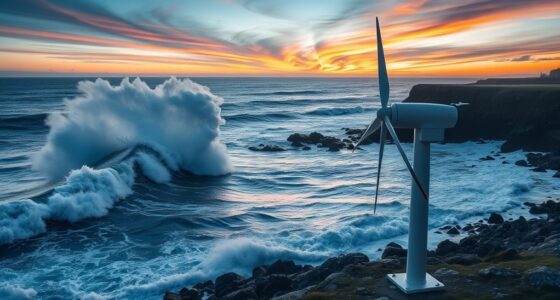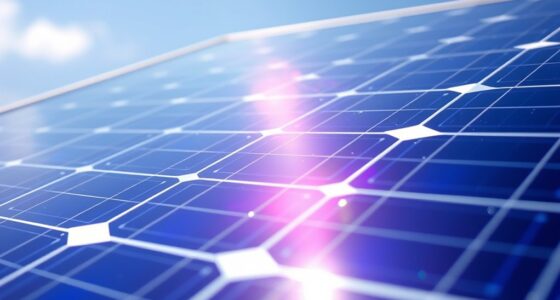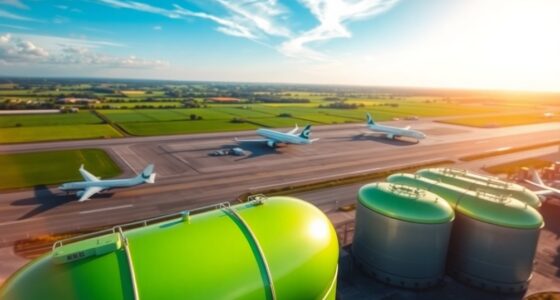New offshore wind-to-hydrogen projects are making waves by harnessing marine turbines to produce green hydrogen sustainably. These projects use ocean winds to generate electricity, which then splits water into hydrogen and oxygen through electrolysis. With reliable offshore winds and advanced infrastructure, they enable large-scale, emission-free fuel production. If you want to discover how these innovations are shaping a cleaner energy future, there’s more to explore below.
Key Takeaways
- New offshore wind projects are harnessing marine turbines to produce green hydrogen through electrolysis.
- These projects utilize durable, high-efficiency turbines designed for harsh ocean conditions.
- Infrastructure developments like pipelines and storage enable large-scale, reliable hydrogen transport.
- Innovation in electrolysis and turbine technology accelerates the scalability of offshore wind-to-hydrogen systems.
- These initiatives support global decarbonization goals and demonstrate a shift toward sustainable, renewable energy sources.

Offshore wind energy is rapidly transforming the way we generate clean power, and now it’s paving the way for hydrogen production. As the industry advances, new projects are harnessing the power of marine turbines to produce green fuel—hydrogen generated without emitting greenhouse gases. These innovative systems leverage the strength of winds over the ocean, turning turbines into a dual-purpose solution: generating electricity and powering hydrogen electrolysis. Marine turbines are specially designed to withstand harsh ocean conditions, allowing them to operate efficiently for decades. This durability ensures consistent, renewable energy input for producing green fuel, making offshore wind a cornerstone in the transition toward cleaner energy sources.
You’ll find that these projects are not just about generating electricity but also about creating a sustainable hydrogen economy. The process involves using excess wind power to run electrolysers, which split water into hydrogen and oxygen. Because the electricity is sourced from renewable offshore wind farms, the resulting hydrogen is classified as green fuel—completely carbon-free and *imperative* for decarbonizing sectors like transportation, industry, and heating. This approach reduces reliance on fossil fuels and cuts emissions, moving us closer to global climate goals.
The integration of marine turbines with hydrogen production facilities offers several advantages. First, the consistent availability of offshore winds means a reliable energy supply, unlike intermittent sources like solar. Second, offshore locations allow for large-scale deployment, making it feasible to produce significant quantities of green fuel. Additionally, these projects often include pipelines and storage solutions, *guaranteeing* that hydrogen can be transported efficiently to where it’s needed most. This infrastructure development is *essential* for creating a *full-spectrum* hydrogen supply chain that supports diverse industries and energy grids.
Furthermore, advances in marine turbine technology enhance the efficiency and resilience of these systems, ensuring long-term sustainability and performance. By investing in offshore wind to hydrogen projects, you’re part of a broader movement toward sustainable energy. These initiatives demonstrate how combining wind power with hydrogen production maximizes renewable resources and reduces carbon footprints. They also open pathways for technological innovation, from more efficient marine turbines to advanced electrolysis methods. As these projects evolve, expect more collaborations between governments, tech firms, and energy providers, aiming to scale up green fuel production and integrate it into existing energy systems. This synergy will help you see a future where clean, renewable energy isn’t just an option but a dominant force powering your daily life.
In essence, offshore wind to hydrogen projects are making waves by transforming ocean winds into a versatile, green fuel source. Marine turbines play a *pivotal* role in this transition, providing the renewable energy needed to produce hydrogen sustainably. As you watch these developments unfold, it’s clear that this isn’t just a technological shift but a fundamental change in how we think about energy—clean, reliable, and abundant, all thanks to the power of the sea.
Frequently Asked Questions
What Are the Main Environmental Impacts of Offshore Wind to Hydrogen Projects?
You should consider that offshore wind to hydrogen projects can impact marine ecosystems by disrupting habitats and migration patterns. Noise pollution from construction and operation may disturb marine life, affecting communication and navigation. While these projects aim to reduce carbon emissions, you need to weigh their potential environmental impacts carefully. Responsible planning and mitigation measures can help minimize damage to marine ecosystems and reduce noise pollution.
How Cost-Effective Are These Projects Compared to Traditional Energy Sources?
You might think renewable projects cost more, but offshore wind to hydrogen ventures are becoming increasingly economically viable. Their market competitiveness improves as technology advances and costs drop, making them more attractive than traditional energy sources. While initial investments are high, long-term benefits like reduced emissions and energy security boost their cost-effectiveness. So, these projects are shaping up to be a smart, sustainable alternative in the evolving energy landscape.
What Regulatory Hurdles Exist for Offshore Wind-To-Hydrogen Development?
You’ll face regulatory hurdles like maritime regulations that govern safety and environmental standards, which can delay project approval. Grid integration also poses challenges, requiring coordination with existing energy infrastructure and ensuring reliable power transfer. Managing these regulations demands thorough planning and compliance efforts, but addressing them early helps streamline development. Understanding and working within maritime and grid regulations is crucial to successfully bringing offshore wind-to-hydrogen projects online.
How Long Does It Take to Implement a Typical Offshore Wind-To-Hydrogen Project?
Picture a project’s path from plan to production, progressing through precise phases. Typically, an offshore wind-to-hydrogen project takes about 5 to 10 years to implement. The timeline depends on planning, permitting, and construction phases, each presenting unique challenges. You’ll navigate feasibility assessments, securing approvals, and building infrastructure, with delays sometimes stretching the process. Patience and perseverance turn promising projects into powerful, productive realities.
What Technological Innovations Are Driving These Projects Forward?
You’ll find that innovative materials, like advanced composites, make turbines more durable and efficient, helping projects progress faster. Automation technologies, such as remote monitoring and robotic maintenance, reduce costs and improve safety. These innovations streamline construction and operation, enabling quicker deployment and scaling of offshore wind-to-hydrogen projects. By adopting these cutting-edge solutions, you can accelerate development, lower risks, and boost the overall viability of renewable energy initiatives.
Conclusion
As you watch these new offshore wind projects emerge like giants awakening, remember they’re not just generating energy—they’re fueling a future where hydrogen becomes the bridge to cleaner skies. Imagine standing on a dock, watching wind turbines turn like giant lighthouses guiding ships to a greener horizon. With over 30 gigawatts of offshore wind planned worldwide, you’re witnessing a powerful wave of change—one that promises to carry us toward a sustainable tomorrow.










